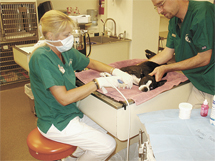
Pet Health Education
Brushing your pets teeth
 "Brush the dogs teeth? You've got to be kidding me"! Ask any vet in the valley, and they'll tell you they've heard this more times than they can count. Ironically, it's usually being said by a very concerned pet owner, someone who wants their animal to have all the latest in veterinary preventative medicine, someone who considers their pet a part of the family. In the past few years, dental hygiene has been shown to be one of the cornerstones of good preventative medicine.
"Brush the dogs teeth? You've got to be kidding me"! Ask any vet in the valley, and they'll tell you they've heard this more times than they can count. Ironically, it's usually being said by a very concerned pet owner, someone who wants their animal to have all the latest in veterinary preventative medicine, someone who considers their pet a part of the family. In the past few years, dental hygiene has been shown to be one of the cornerstones of good preventative medicine.
Just like with you and me, unbrushed animal teeth acquire a layer of nasty tartar. Tartar builds on itself, making a perfect environment for bacteria to grow, and slowly but surely breaks down the periodontal ligament that holds the tooth firmly in the mouth. (Not to mention a lot of bad breath! How many among us haven’t wanted to run for cover when the dog pants in our faces?) An untreated mouth can also lead to larger health problems that a deteriorating set of teeth and gums. Bacteria growing in the tartar can mobilize into the bloodstream and spread to major organs like the heart and kidneys. Infections in the major organs can be life threatening and difficult to treat.
“So you’re really serious about the tooth brushing thing”? Yes! Take a good look into your dog or cat’s mouth. What do you see? What you would hope to see would be rows of clean white teeth without any yellow, brown or green build-up. You’d also want to see pink health gums with no redness or swelling around the teeth.
If your pet is older than one or two years though, chances are good you will see at least one or two of the changes mentioned above. What do you do about it? Your first step should be to consult with your veterinarian. If the changes in your pet’s mouth are mild enough, simply beginning a good at-home oral hygiene program will delay further problems. But if things have progressed from mild tartar to gingivitis or even periodontal disease, your vet may recommend dentistry. Dentistry’s in animals are very similar to a human’s visit to the dentist. The teeth are scaled, probed, polished; fluoride treatment, and any necessary advanced work such as extractions are done – with the exception that it is all done under anesthesia. Your pet awakens to clean teeth and fresh breath! (You will be more excited about this than he will).
Once the dentistry is performed, home care is a necessity. Brushing teeth is the mainstay of home care. Brushing does not mean your pet may never need dentistry, but it will definitely increase the time between professional cleanings. The most effective technique involves using either a soft bristled toothbrush or a finger brush, and dog or cat toothpaste (nontoxic if swallowed). The outer surfaces of the teeth and gums are gently brushed or rubbed as thoroughly as possible. Most animals love the taste of their special toothpaste, and after a few tries they will start to enjoy their brushings. Puppy and kitten owners: Start Young! Accustoming your pet to fingers or brushes in its mouth at a young age makes lifelong care much simpler. Mouth sprays, rinses, and safe chew toys are also available, and can do a wonderful job at promoting good oral hygiene, if they are used consistently.
Whether your pet is a pampered member of the family or earns its living by guarding or herding, good oral hygiene can make for a happier (those diseased teeth and gums hurt!) and healthier animal. The idea here is prevention. By taking care of the mouth, we may be preventing serious health problems involving the heart kidneys, or liver later in life, not to mention the dental disease of the present. Wouldn’t it be nice to finally say goodbye to dog bad breathe!
Animal Health Services is offering a free dental kit valued at $75 when your pet receives dental services during “Dental Month.”
For more information and to make an appointment call 480-488-6181.
Courtesy Photo: Animal Health Services professionals providing pet dental care.
